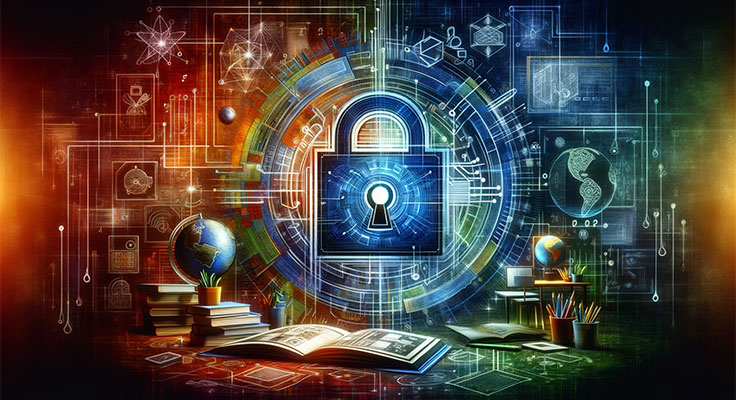
In an era where technology intertwines with every aspect of daily life, the education sector resists digital transformation. While enriching the educational experience, this shift brings forth significant cybersecurity concerns. Safeguarding student data and privacy in educational institutions is a complex, multifaceted challenge, necessitating a deep dive into the strategies and measures necessary for effective cybersecurity in education.
The Rise of Digital Learning and Its Cybersecurity Implications
Evolving Threat Landscape in Education
Integrating technology in classrooms, from digital textbooks to online learning platforms, has unquestionably enhanced the learning experience. However, it has also exposed educational institutions to many cybersecurity threats. Cyber attackers often view schools as vulnerable targets due to the wealth of personal and academic data stored. The types of threats are diverse, including sophisticated phishing attacks, ransomware, and data breaches, each posing a unique challenge to the integrity and confidentiality of student information.
Importance of Protecting Student Data
The data held by educational institutions is not limited to academic records; it encompasses sensitive information such as student and parent addresses, health records, and social security numbers. The unauthorized access or exposure of this data can lead to devastating consequences. It could mean identity theft, financial fraud, or long-term reputational damage for students.
In these challenging times, if students struggle with their studies amid such concerns, reaching out only to reliable essay writing website can be a practical solution for academic support. It’s crucial, however, that these platforms also adhere to stringent data protection measures. Such breaches in educational contexts affect personal data and can erode trust and result in legal repercussions for the institutions, further emphasizing the critical need for robust data protection measures.
Critical Strategies for Enhancing Cybersecurity in Schools
Implementing Strong Access Controls
Effective cybersecurity begins with robust access control mechanisms. Schools must ensure that only authorized individuals have access to sensitive data. It involves setting up strong, unique passwords, employing multi-factor authentication, and conducting regular audits of who has access to what information. These measures significantly reduce the risk of unauthorized data access from external threats and potential internal vulnerabilities.
Regular Software Updates and Patch Management
The cybersecurity landscape is continually evolving, with new vulnerabilities emerging regularly. Educational institutions must keep their software and systems up to date. It means installing the latest security patches and ensuring that all applications used in the educational setting are from reputable sources and are kept current. Regular updates help protect against known vulnerabilities that cybercriminals exploit.
Building a Cybersecurity-Aware Culture
Technical measures alone are insufficient to combat cyber threats. A significant aspect of cybersecurity involves human behavior. Schools should cultivate a culture where everyone knows the risks and their role in mitigating them. It includes regular training for students, teachers, and staff on identifying phishing attempts, practicing safe browsing, and understanding the importance of data privacy. An informed and vigilant community is a critical line of defense in the cybersecurity landscape.
The Role of Cybersecurity Policies in Educational Institutions
Developing Comprehensive Cybersecurity Policies
An articulated cybersecurity policy is essential for any educational institution. This policy should detail the protocols for data handling, define user roles and access privileges, and establish guidelines for responding to cybersecurity incidents. Such a policy serves as a guideline for current practices and a framework for handling future threats.
Compliance with Legal and Regulatory Standards
In the U.S., educational institutions are governed by various legal and regulatory standards about data protection. One fundamental law, the Family Educational Rights and Privacy Act (FERPA), dictates strict guidelines for safeguarding student educational records. Ensuring compliance with these regulations is a legal necessity and reflects a deep commitment to the ethical treatment of student information. Schools should continuously update their knowledge of these laws and incorporate necessary measures into their cybersecurity protocols.
Leveraging Technology to Bolster Cybersecurity
Advanced Security Solutions
Educational institutions must allocate funds toward the acquisition of a comprehensive cybersecurity suite. This suite should comprise advanced firewall mechanisms, sophisticated intrusion detection systems, and robust encryption technologies to maintain the integrity and confidentiality of sensitive information.
The Role of Artificial Intelligence in Cybersecurity
Artificial intelligence (AI) and machine learning in cybersecurity are significant advancements. These technologies can analyze patterns, detect anomalies, and predict potential threats faster and more accurately than traditional methods. AI-driven security systems can autonomously identify and respond to threats, providing a proactive approach to cybersecurity.
Challenges and Future Directions in Cybersecurity for Education
Balancing Accessibility and Security
One of the most significant challenges in implementing cybersecurity in education is striking the right balance between accessibility and security. Educational resources should be readily accessible to students and staff, but this accessibility should not compromise security. Schools must find solutions that provide easy access while maintaining robust security measures.
Preparing for Emerging Cyber Threats
As technology advances, so do the sophistication and complexity of cyber threats. Educational institutions must remain vigilant and adaptive, continuously updating their cybersecurity strategies. It involves embracing new technologies and fostering a culture of continuous learning and adaptation among all stakeholders.
Conclusion
In conclusion, the importance of cybersecurity in education cannot be overstated. Educational institutions can safeguard student data and privacy by adopting a comprehensive approach that includes strong security measures, continuous education, and adherence to legal standards. In doing so, they protect their students and strengthen the trust and integrity foundational to the educational process.





Leave a Reply